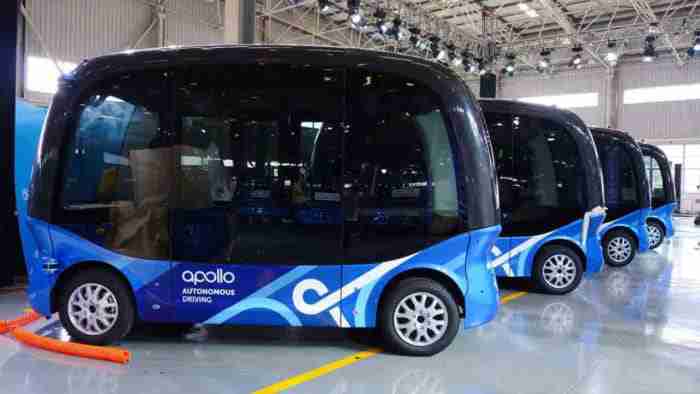
China is really going for it. Within a few months, Chinese tech giant, Baidu, plans to roll out a new robotaxi service in one of the country’s biggest cities.
Baidu, which is essentially China’s answer to Google, has announced several AI-powered transportation projects, including partnerships with Ford and Volvo, focused on advancing autonomous driving.
China is already home to the world’s largest car market — which makes sense given its status as the most populous country, and now, they’re gaining ground on Silicon Valley when it comes to autonomous vehicle research.
What’s the plan?

Autonomous taxis have already hit roads in Singapore, Japan, and Russia — and China’s rollout signifies a potential global shift in how people think about transportation.
Baidu’s plans are the first of its kind. The Level 4 driverless service is powered by Apollo’s Apolong Mini Buses — self-driving shuttles. A quick refresher, the Apollo program is Baidu’s open-source driving platform — essentially software you can drop into any car for an autonomous experience.
The company plans to unveil the taxi service in a few months in the town of Changsha — a city of 7 million in Southern China.
Long term, Apollo’s service can easily be sold to car companies, while the minibusses could be deployed to other markets for commercial use or as a way to fill the gap between buses and individual rideshare services.

Why China is winning the race to 5G
Could disengagement be an issue for robotaxis?
Beijing started testing self-driving cars on public roads back in 2017, becoming the first city in China to allow autonomous vehicle testing.
Last year, eight companies tested 56 vehicles, logging roughly 93k miles of driving in the city. Reports just came out last month, detailing the performance of these vehicles, and it seems that they are missing a key safety metric — how often did humans need to intervene?
This metric is called disengagement and refers to any time that a human is forced to take control over the car.
In California, all companies testing self-driving cars are required to disclose the number of miles driven and how often intervention was required. Quartz mentions that while disengagement is a flawed metric , the Chinese tests fail to disclose how often Baidu’s autonomous cars, as well as Pony.ai and Waymo’s vehicles required human intervention.
So, how autonomous are China’s robotaxis?
If you’re not super entrenched in the world of self-driving cars, autonomy is rated on a scale from 0-5.
A level 0 represents no automation — your average car that you control yourself. A level 5 takes over all driving responsibilities. In this case, the passenger can lean back and zone out —answer emails, watch a movie, no need to keep your eyes on the road.
For a little background on the different levels of autonomy, this video provides a deeper dive.
The Apolong buses are level 4 autonomous — so they’ll need to be monitored but will control all aspects of the driving experience.
Between Baidu’s partnerships and the upcoming taxi launch, China could potentially be the world’s largest market for autonomous vehicles.
According to a report from McKinsey , if successful, autonomous vehicles could solve some of the country’s major problems — like traffic congestion and pollution.
But, it’s worth considering the economic implications that come with the move toward self-driving.
The report brings up the point that autonomous vehicles could take over the bulk of the country’s mobility services — which stands to shake up the country’s economic order, shifting the center of the automotive industry to software and data — rather than auto manufacturing jobs.
Related Articles
Tesla to show off new self-driving technology ►
Pizza Hut wants autonomous pizza vans ►
What we know about Amazon’s foray into self-driving cars ►
Uber pushes for self-driving cars ►